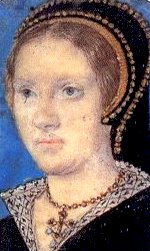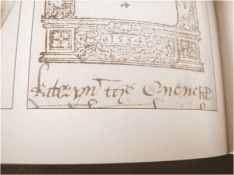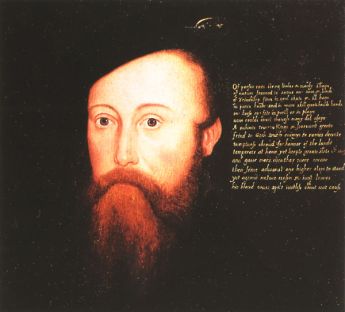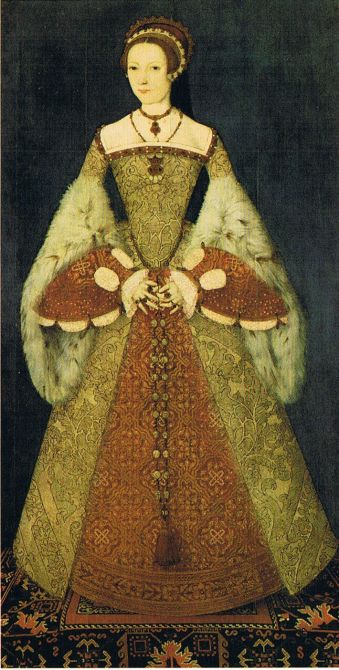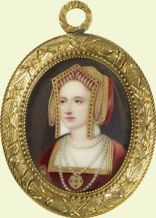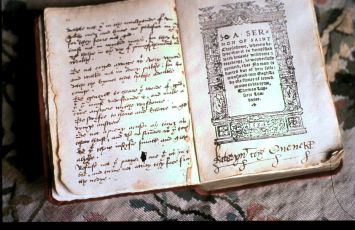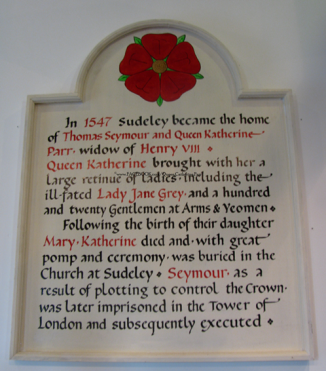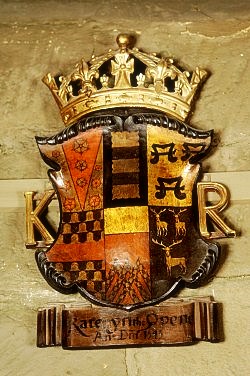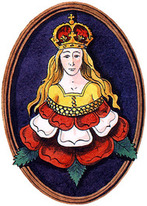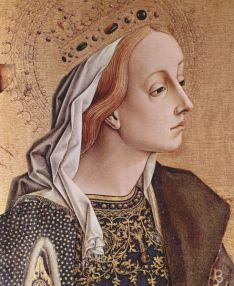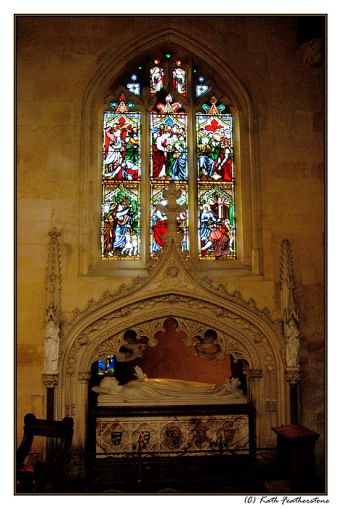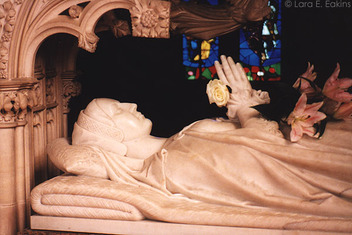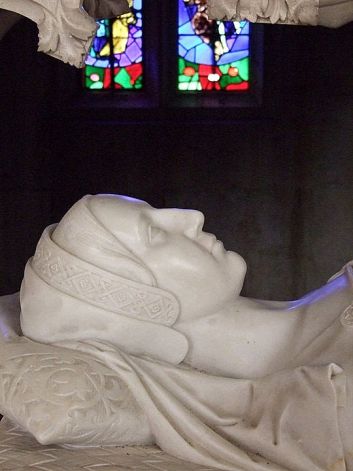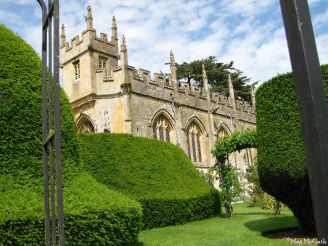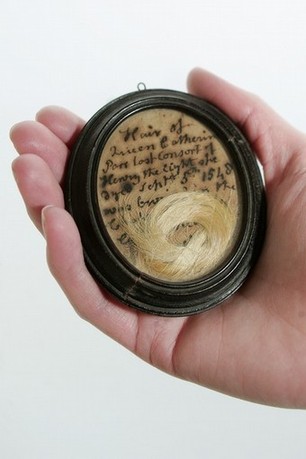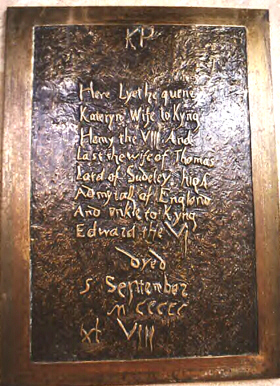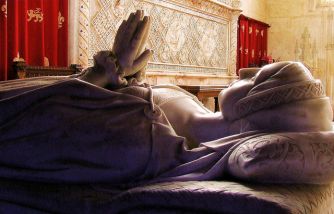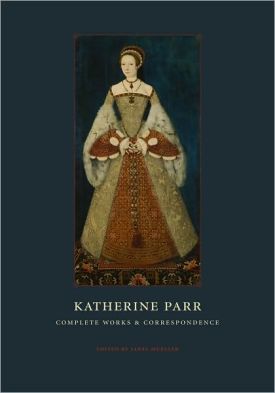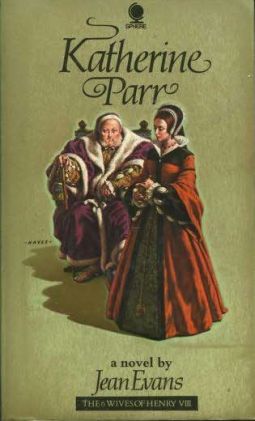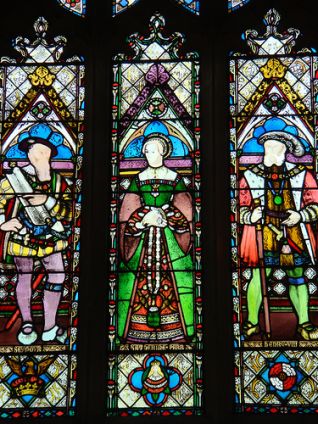Catherine Parr Historical Profile
Jump to navigation
Jump to search
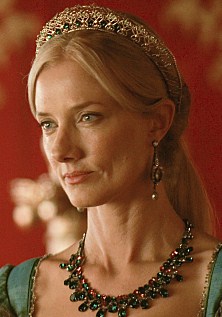 |
INTERESTING FACTS:
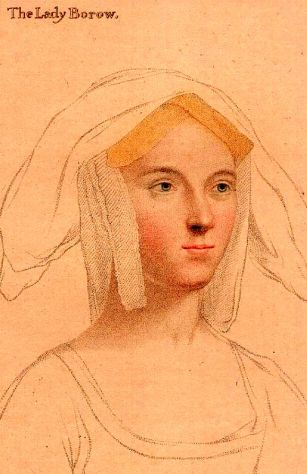 Copy of a Sketch by Hans Holbein of "Lady Borow" was thought by some to be Catherine. Catherine's father-in-law, Sir Thomas Borough, 1st Baron, during the time of Catherine's marriage to his son, Edward, commissioned a portrait by Holbein, of his wife Agnes Tyrwhitt, the Lady Borough at the time. Lord Borough had to pull his connections and power at court just to have this done, so this portrait is most likely Agnes. (Linda Porter, Katherine the Queen, pg 55) | 'Lord, hearken to my words. Consider the thought of mine heart. Behold, how loud I cry unto thee. Let my just prayer enter into thine ears, which unfeignedly cometh from mine heart. Hear me, Lord, for I am poor and destitute of man's help. Take care for my soul. Save me, thy servant, which wholly trust in thee. Have mercy upon me, O Lord, for I will never cease crying to thee for help.' ~ a prayer written by Catherine Parr 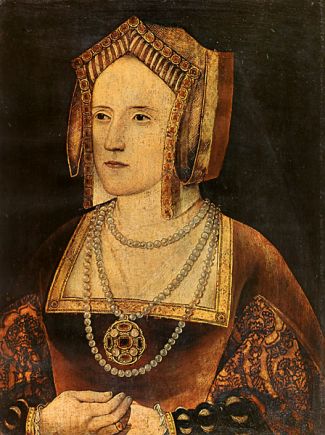 This portrait, long thought to be that of Catherine Parr as Lady Latimer, is now labeled as Queen Katherine of Aragon. The portrait has been used in other depictions featuring all six wives as Catherine Parr. A miniature commissioned by Queen Victoria is based on this portrait; the title names the woman as Katherine Parr. Susan James and Linda Porter in their recent biographies believed that this portrait was the earliest known portrait of Catherine as Lady Latimer. <a class="external" href="http://www.dailymail.co.uk/news/article-2268192/Lambeth-Palaces-Catherine-Parr-portrait-actually-Henry-VIIIs-wife-Catherine-Aragon-says-National-Portrait-Gallery.html" rel="nofollow" target="_blank"> </a><a class="external" href="http://www.dailymail.co.uk/news/article-2268192/Lambeth-Palaces-Catherine-Parr-portrait-actually-Henry-VIIIs-wife-Catherine-Aragon-says-National-Portrait-Gallery.html" rel="nofollow" target="_blank">Catherine of Aragon reunited with </a><a>King Henry VIII... but only as an oil painting</a> Four Marriages 1. Sir Edward Borough, Burgh (Borow) Married from 1529 until 1533 (his death) At age 17, Catherine's first marriage, arranged by her mother, was to Sir Edward Borough. It had been thought that Catherine married the elderly Edward Borough, 2nd Baron Borough of Gainsborough in 1529, but the 2nd Baron died in August 1528. This notion that she was the wife of Lord Borough was fueled by 19th century historian Agnes Strickland. Through the recent research of documents and the will of Catherine's mother by biographers Susan James and Linda Porter is had been confirmed that she married the 2nd Baron's grandson, who shared his first name. This discovery was not a new one as in 1994, Antonia Fraser, and again in 2004, David Starkey's book on Henry's wives also confirmed that Catherine's first husband was the 2nd Baron's grandson. Sir Edward Borough was the eldest son of the 2nd Baron's eldest son, Sir Thomas Borough, who would become the de jure 3rd Baron in 1529 (Thomas was summoned to Parliament as 1st Lord Burgh of Gainsborough, a new creation, as his father was never formally summoned as the 2nd Baron due to his state of mind). In her will, dated May 1529, Maud Parr, mentioned Sir Thomas, father of Edward, saying 'I am indebted to Sir Thomas Borough, knight, for the marriage of my daughter'. Edward died in the spring of 1533, predeceasing his father; he never fulfilled the title of Lord 'Borough' Burgh. 2. John Neville, Lord Latimer Married from c. 1534 until March 1543 (his death) Catherine could have met her second husband at court functions when she was 22, after Anne Boleyn became queen. After her marriage to Edward Borough, Catherine stayed with her cousin's, the Strickland's. Lady Strickland was a cousin of Lord Latimer. John Neville had already been married twice. Neville was a cousin of Catherine's father. Neville had two children by his first marriage to Dorothy de Vere, when he married Catherine. He was at that time aged 42. Catherine was the lady of a huge household at Snape Hall in Yorkshire. Although Lord Latimer preferred to remain at Snape Hall, he and Catherine became embroiled in the intrigue of Anne Boleyn and Henry and Cromwell. In fact, after Anne Boleyn was executed, they came very close to losing their own lives during the Pilgrimage of Grace. They returned to London in 1536, when Queen Jane Seymour was three months pregnant. This had put the King in an exceptionally good mood, and --for the moment-- the political nightmare which had affected her family due to Neville's supposed involvement in the Pilgrimage came to an end for Catherine and her family. Latimer would be taxed by Cromwell for the rest of his life and the emotional scars never healed for Latimer. Queen Jane gave birth to Prince Edward in October. 3. King Henry VIII married in 1543 until January 1547 (his death) Catherine was aged 31, younger than Anne Boleyn had been when she married the King, and Henry was 52 and ailing. The two were married until Henry's death in January 1547. 4. Thomas Seymour (above) Married from March 1547 until her death in September 1548 (aged 36). Catherine's only love match. It was later suggested that Seymour tried to initiate an affair with the young Lady Elizabeth Tudor. (see Controversies of the Tudors) Elizabeth was eventually sent away, to prevent Seymour from further temptation. After Catherine's death, (most likely from childbed fever) Thomas Seymour was beheaded for treason within less than a year. Lady Mary Seymour--the daughter to whom Catherine had given birth--was taken to live with Catherine Brandon, now Dowager Duchess of Suffolk; she had been a close friend of Catherine Parr. After a year and a half, the infant Mary's property was restored to her by an Act of Parliament. The financial burden on the Dowager Duchess for the maintenenace of the child's household was thereby eased. The last mention of Lady Mary Seymour on record is on her second birthday. Stories circulated that Mary eventually married and had children, but most historians believe she died as a child. Note at the National Portrait Gallery (London)...Lady Jane Grey or Catherine Parr For many years thought to represent Lady Jane Grey, the painting has recently been re-identified as Catherine Parr, with whose name it was originally associated. The full-length format was very rare in portraits of this date, and was usually used only for very important sitters. Lady Jane Grey, although of royal blood, was a relatively obscure child of eight when this was painted; it was to be another eight years before her disastrous and short-lived reign. The distinctive crown shaped jewel which the sitter wears can be traced to an inventory of jewels belonging to Catherine Parr and the cameo beads appear to have belonged to Catherine Howard, from whom they would have passed to her successor as queen.
| ||
| Catherine Parr's Greatest Challenge came in the Summer of 1545: Some courtiers who were jealous of her influence over the King tried to link her with heresy. Bishop Stephen Gardiner warned Henry against harboring "a serpent within his own bosom." A list of charges had, in fact, been drawn up by early July 1545, and the stage was set for the Queen's arrest. Henry had become sufficiently irritated lately by some of his wife's freely expressed progressive views. She had on one recent occasion been unwise enough to forget that in any debate--especially one of a theological nature--the King had always to win hands down. Unfortunately, Henry had at that point been willing to listen to hints being dropped about Kate's dangerous opinions, so 'stiffly maintained.' Ultimately, however, he apparently decided that matters had gone far enough. At that point, he allowed Catherine to be warned of what was being prepared for her. Henry steered the conversation to religion, commenting that "ye are become a doctor, Kate, to instruct us . . .," but Catherine had the perfect response: "I am but a woman, with all the imperfections natural to the weakness of my sex; therefore in all matters of doubt and difficulty I must refer myself to your Majesty's better judgment, as to my lord and head." She had quickly seized her chance to explain that she had only been bold enough to seem to engage in argument with her lord and master, in order to distract him from the pain of his ulcerated leg. She also claimed that through this surface-only 'debate,' she herself might profit from hearing the King's learned discourse. When Wriothesley arrived with 40 yeomen of the guard and a warrant for the Queen's arrest in his pocket, he was greeted with a tirade of royal abuse from the King, who shouted: "Knave!," "Fool," and "Beast!," and sent Wriothesley packing with his tail between his legs. Henry 'made it up to' Catherine with a set of gorgeous new jewels.
| ||
SEE ALSO :
| LINKS:
| ||
| Tomb of Catherine Parr in the renovated St. Mary's Church, Sudeley Castle. Because of the destruction of her tomb and the re-burial of her coffin it is most likely why, of all of Henry's wives, Catherine has the most magnificent tomb. Picture courtesy of Keith Featherstone. | |||
| In 1782, a gentleman by the name of John Locust discovered the coffin of Queen Catherine in the ruins of the chapel at Sudeley Castle. He opened the coffin and observed that the body, after 234 years, was in a surprisingly good condition. Reportedly the flesh on one of her arms was still white and moist. After taking a few locks of her hair, he closed the coffin and returned it to the grave. The coffin was opened a few more times over the next ten years, and in 1792 some drunken men buried it upside down in a rough manner. When the coffin was officially reopened in 1817, nothing but a skeleton remained. Her remains were then moved to the tomb of Lord Chandos, whose family owned the castle at that time by orders of the late Duchess of Buckingham. In later years the chapel was rebuilt by Sir John Scott, and a proper altar-tomb was erected for Queen Catherine. 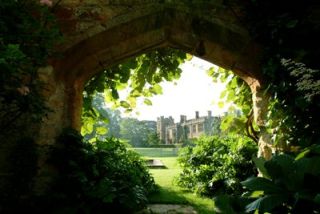 | 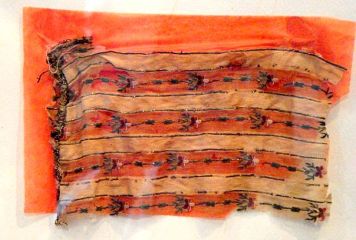 A piece of fabric said to be from the dress Catherine Parr was wearing in her coffin. 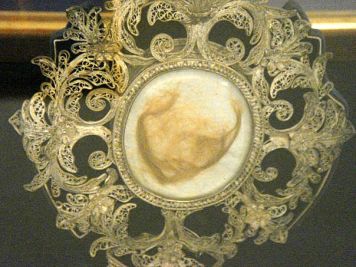 A lock of Catherine's hair. [Source: Nasim Tadghighi] 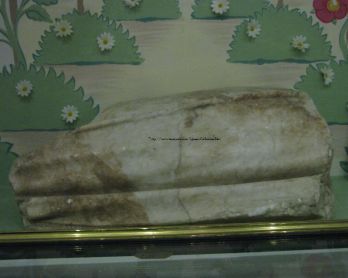 A piece of the original tomb Catherine was found in; on display at Sudeley Castle. | ||
Another lock of hair believed to belong to Catherine. The inscription reads "Hair of Queen Catherine Parr, last consort of Henry, the night she dyed September 5th 1548 was in the Chapel of Sudeley Castle, near Winchcombe." This artifact was on display at Hampton Court Palace in the "Henry's Women" collection of paintings and other artifacts. | |||
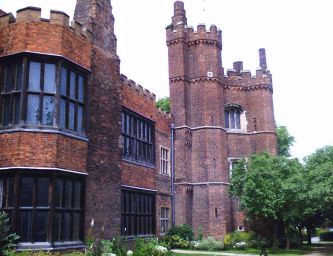 Old Gainsborough Hall built in 1460 by Sir Thomas Burgh, 1st Baron Burgh of Gainsborough, great-grandfather of Sir Edward Borough (Burgh), Catherine's first husband. Catherine and Edward lived with her in-laws until 1530; when the couple moved to their own manor in Kirton-in-Lindsay. 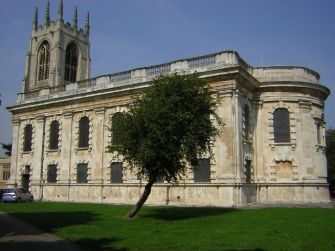 All Saint's Church in Gainsborough near where Catherine lived. She most likely worshiped here. Like many structures, the original church was destroyed during the English Civil War. This is the restored church which was built in the same style as St. Martin-in-the-Field's in London. | 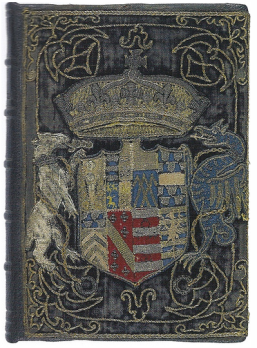 Copy of Il Petrarcha con l’espositione d’A. Vellutello; con le figure a i triomphi et con piu cose utili in varii luoghi aggiunte (1544) owned by Catherine Parr British Library, C.27.e.19. Copy of Il Petrarcha con l’espositione d’A. Vellutello; con le figure a i triomphi et con piu cose utili in varii luoghi aggiunte (1544) owned by Catherine Parr British Library, C.27.e.19.This volume of Petrarch’s works, with an exposition by Alessandro Vellutello, was first published in Venice. The book is bound in purple velvet and embroidered with gold and silver thread and coloured silks. The coat of arms topped with the royal crown may have been embroidered by Catherine. The arms are not Catherine's royal arms, but rather that of her brother, William Parr. The book appears to have been bound after the death of Henry VIII (in January 1547) and before Catherine’s marriage to Sir Thomas Seymour. Had it been bound whilst Henry was still alive, it would be expected that the supporters (the creatures flanking the coat of arms) would be the lion and the greyhound. As there is no reference to Seymour, it seems it was made sometime in the short space of Catherine’s widowhood. It was subsequently owned by the Fitzhugh family (whose emblem of the creature breathing flames and gorged with a coronet, is depicted on the left). The FitzHugh's were cousins of Catherine through her grandmother, Hon. Elizabeth FitzHugh. The creature on the right – a wyvern argent also gorged with a coronet – belongs to the Parr family. The book went on public display in 2009 for the Henry VIII: Man and Monarch exhibit at the British Library. The event was to mark the 500th anniversary of Henry VIII’s accession | ||
LITERATURE: Non-Fiction:
| Fiction:
| ||
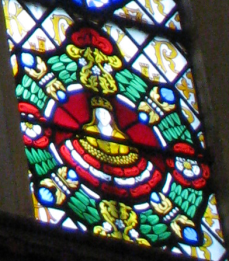 Stained glass window showing Catherine's badge in Hampton Court Palace 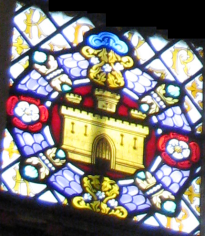 Pictures courtesy of GOLDENAGED.ER 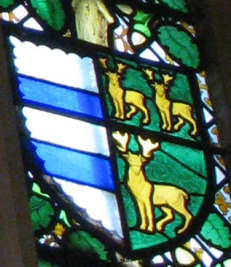 Catherine Parr's Pedigree Window at Hampton Court, her parents arms. Sir Thomas Parr (left) and Maud Green (right). | 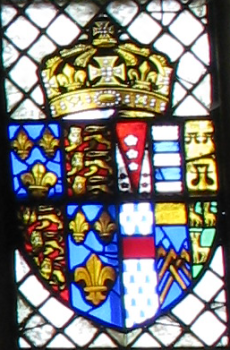 Stained Glass window in Hampton Court Palace showing Catherine Parr's coat of arms. Courtesy of <a href="../account/GoldenAged.ER" target="_self">GOLDENAGED.ER</a> | ||
<embed flashvars="transition=Fade&site=http://tudorswiki.sho.com&imageServer=http://image.wikifoundry.com&albumId=42468" height="400" src="http://wikifoundrytools.com/wiki/thetudorswiki/widget/unknown/eb5e064ca030aca5a001e8c93f06848521faf375" type="application/x-shockwave-flash" width="400" wmode="transparent"/>
